
|
|
Using rising columns of air to keep your rocketaloft for longer times
This article originally appeared in the January 1993 issue of the"Journal of the International Space Modeling Society."
By George Gassaway and Ken Mizoi
Usually in competition we look for anything that can help keep ourmodels in the air for a longer time than they would get bythemselves. It doesn't really matter what it is that helps, whetherit is a thermal, wave lift, slope soaring, whatever. For purposes ofour discussion, the types of lift discussed will be mostly of thethermal type. That in itself is hard enough to describeadequately.
This is also meant as a supplement to other articles aboutthermals. There is not much need to restate all that is describedjust as well in other sources. One great resource is an articlewritten by Bill Forrey {see references}.
One of the big problems about discussing thermals is that thereare several kinds of thermals, of varying strengths, and numeroustheories and tips from other experts which do not necessarily agree.There are so many that to try to remember and analyze it all is justabout impossible, it is hard to ever even know what KIND of thermalyour model caught (or missed, as the case may be). It is also verydifficult for someone to try to describe what they tend to look for,as it is often a combination of factors at a given moment, some ofwhich may be subconscious concepts. Thermals are very hard toquantify, which is notable by how no two thermal articles seem to bealike. Every person has their own concept of thermal types and how touse them.
Or as some people have described it, it is a "Black Art". The onlyreal way to learn is to read all you can, pick up what you seem to beable to keep track of for learning, get your own detection gear suchas a thermal pole to learn with locally, start paying lots ofattention to what the air is doing on the field, and note whattheories and techniques work well enough for you to become somewhatconsistent spotting thermals.
Thermal Heating
Thermals are formed by a difference in temperature of the air, andas we all know, hot air rises. It does not have to be "hot" or evenwarm though, thermals can form in winter if there is sufficient meansfor some cold air to become less cold than the surrounding air. Airdoes not retain or absorb heat well, it has to be heated by somemeans - generally by the ground. In most cases, the ground is heatedby the sun, then the air at ground level is itself heated by contactwith the ground.
The sun is usually the key to thermals. Ideal sun conditions areclear blue sky with the sun high in elevation, such as near noon.Highest maximum elevation occurs in late June, thermals do tend to bestronger in late spring and early summer than at other times of year.Thermal activity usually starts up around 9-10 AM and dies off by 4-5PM. Contests are usually flown during that time frame anyway. The"prime time" hours are often between 11 and 3 PM, when the strongestthermals of the day usually occur. During NAR contests this can beexploited, during FAI contests it is harder to make use of since therounds determine when you fly. Even if a day starts off nice andclear, it may very likely become partly cloudy later on as some ofthe larger thermals form cumulus clouds. They may even form into lateafternoon showers or thundershowers. As such, it may be risky to waittoo long in the day to fly some events at NAR meets.
On partly cloudy days there will be less sunlight delivered, andgenerally weaker thermals. Sometimes fliers wait for a cloud to passby to reheat the ground and help form a new thermal. However, such acycle can take a long time, at a NARAM you can literally have all dayto wait for that if you want to, but under rigid round flying thereprobably will not be time. How long it takes the ground to reheat andform a thermal can range from several minutes to never, though if youplan to wait it out it will probably be at least 5-10 minutes afterthe sun reappears. Under most FAI round time frames, there may not betime to wait it out though.
Topography makes a major difference in how much and to whatstrength thermals can be formed. The best sites are those whichabsorb heat well, such as a plowed field or area with a lot of pavedsurface, surrounded by areas which do not absorb heat well, such asforests and areas with a lot of plant life. A farmer's field is greatif it's been plowed under, the rough ground even presents moresurface area to absorb heat from sunlight. But that same farmer'sfield could also be a "black hole" if it's planted with crops.Humidity also plays a role, the more humidity the less activity thereis and the cooler some sites may tend to be. This is why some ofthose "Texas-sized" thermals get to be so strong, not just thecapability of a lot of hot spots. Some of you may have noted it wasless humid in Dallas than at NARAMs flown in Houston, Orlando, orManassas. Similarly, flying over a pond or lake would not be a goodidea in general through the day, although in late afternoon it mightgenerate some lift as the ground cools but the water retains heatlonger. A similar "heat sink" effect can occur from paved areasretaining heat late in the day or after the sun has been replaced bya buildup of cloud overcast.
Back to sites, what we often fly from tend to help generatethermals, or add to ones that have drifted from elsewhere "upwind".Rocket sites usually have short grass, tall weeds, dirt, pavement, ora mix of several of these (the tall weeds and grass is not so ideal,but often better than surrounding areas). Sites with a significantamount of paved areas tend to help generate good thermal activity, asthe pavement absorbs heat from the sunlight better than othersurfaces.
All of this helps to form a heated mass of air, laying underneathcooler air. Eventually something will trigger the warm air layer torise upward.
 |
Thermal Formation
When the air is heated enough, or the amount of warmer air islarge enough, it will tend to bulge upward. As it does, it willdisplace some of the cooler air. This bulge will become larger, intoa bubble which bursts through the cooler air. This rising bubble is athermal, though in an early form. This bubble usually tends to forminto a vortex ring, like a "smoke ring" . If the bubble or ring losesall contact with the ground, it will truly rise like a bubble, and bevirtually impossible to detect from the ground. The only way ofdetecting that would be to happen to fly a model into one, unless thethermal happened to be detected as it was forming or breaking awayfrom the ground.
 |
Stronger thermals usually do keep contact with the ground, via arotating column which helps to feed the thermal. This column issometimes visible by the dust kicked up by it.. If the warm or "hot"spot that formed the thermal warms up additional air quickly enough,and/or if the wind is not too strong or turbulent, the column maystay connected to the source and create a virtually stationarythermal. Unfortunately this is rare. More often, the thermal driftsdownwind on its own, picking up more warm air as it goes. It may helpto create warm air by its own influence of calming the wind in thedirection it is drifting towards, allowing the air in front of it tobecome more heated, or it may simply "harvest" other warm spot areaswhich have not yet burst through but are warm enough to feed thethermal as it goes by.
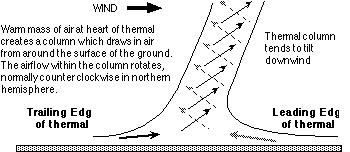 |
The kinds of thermals we often seem to pick are ones that are ofthe forming bubble or the developed column variety. Both give offclues of warmer air, shifts in wind, and of course, rising air.
As the bubbles, or the columns, pull in air from ground level,there is a tendency for the air at ground level to move towards thebubble center or thermal column core. After all, if there is warm airrising, air must come in to replace it. Also remember that wherethere is air rising, there is also air falling, at the outer fringesof rising air there is falling air or "sink". Notice the top view infigure 4 how much air is affected around the core It can be deadly toget caught in sink if you miss the thermal. That's what makes thissuch a risky venture.
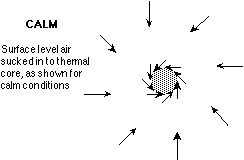 |
As air is pulled in from the sides at ground level, it oftenrotates. A just forming bubble may not show such a clue, but athermal column cannot exist without it. The rotation is usually,though not always, counter-clockwise. The size of the column corevaries greatly, sometimes just 1-2 feet in diameter of a weakthermal, sometimes a hundred feet more at ground level (the area ofrising air is much wider than the column, especially at higheraltitudes, though just how wide cannot be said) . Beyond thatrotating column "wall" though, there usually does not seem to be muchnotable rotation.
Wind
It is important to become attuned to the behavior of the wind, asthat is one of the most useful clues in trying to locate a thermal.It is important to note direction, velocity, smoothness orturbulence, and most importantly, when and why it changes directionand/or velocity. And never think that the wind is "blowing down thefield"; the chances of the wind blowing in a particular direction areone in 360, as in 360 degrees. The wind is going to blow whateverdirection it wants to, regardless of what the shape of the flyingfield is like or your concepts of where it "ought" to go.
One of the first things to make note of on the field is the winddirection and velocity. Keep a mental note of the direction andvelocity, to develop a feel for what is the general wind directionand intensity. Throughout the day the wind will usually becomestronger (until later afternoon when thermal activity also diesdown), and the direction may permanently shift, so that you'll needto update your impression of the general wind, its general behaviorin the previous hour (or even half hour) is of more value than whatit was like 3-4 hours before. The reason the general wind directionchanges significantly through the day can be due to several factors,such as approaching pressure and weather fronts. In lighter windconditions, the wind can shift due to interaction of the region'stopography and weather. It helps to check the weather forecasts forwhat the expected weather for the day is supposed to be, includingwind direction and strength. If the wind direction is significantlydifferent from what it is supposed to be, you'll know to be aware ofa likely permanent shift later in the day.
The reason for getting a feel for the general wind is thatthermals cause localized changes in the wind. The thermals are pushedalong by the general wind, but do create their own apparent shifts inwind. Those shifts in wind can be used to help in locating a thermal.However the shifts can tell you very little, and could be misleading,if you do not have a good feel for the general wind to compare it to.Otherwise you won't know how or why it's different.
As described earlier, the air at ground level tends to be pulledin towards the thermal. This is a form of "wind" created by thethermal itself. If conditions are very calm, then a thermal can oftenbe located easily simply by a shift in the wind. The wind will blowright towards the thermal, because in effect the wind IS the thermal.Take note of clues that will show wind shifts, and velocity, such asthermal poles with mylar streamers, bubbles, and far-off clues suchas flags on flagpoles and windsocks.
When there is some significant general wind, the thermal's windeffect will interact. There often will still be some notable windshifts, in both direction and velocity. Figure 5 shows the net vectorof the combination of general wind and air pulled in by thethermal:
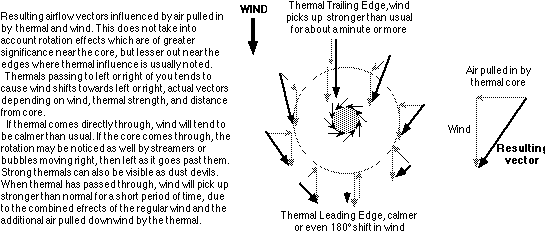 |
The air pulled in by the thermal changes the relative localizeddirection and/or velocity of the general wind. The relative winddirection along the sides of the thermal still tends to deflect leftor right depending on thermal location, but not straight at thethermal as seen under calm conditions. For another drawing showingthis same effect, see the Fig. 9 of the R/C Soaring column from theJuly '89 Model Builder, a copy of which was provided in the Oct '90Technology Development mailing.
Two other areas of special note are the behavior of the leadingand trailing edges of the thermal. The air pulled in at the leadingedge of the thermal tends to cancel out some of the velocity of thegeneral wind. In other words, as the thermal approaches you orequipment such as a thermal streamer, the wind will seem to getcalmer. How calm will depend on how much air the thermal is pullingin, and the velocity of the general wind. For example here, let's saythe general wind is 10 MPH and the thermal is strong enough to pullin air at about 5 MPH (this is only for understanding the concept,not reflecting true behavior. The intensity varies with the size ofthermal and how close by the core is). For a time, the wind will tendto feel as though it has dropped from 10 to 5 MPH. As the core movesthrough this will tend to change, though it will depend on where thecore is located relative to you and the strength and size of therotating core (up to now the rotation effect of how the thermalaffects wind has been ignored. It seems that a longer distances fromthe core the rotation is not noticeable enough to consider in thisregard).
As the thermal passes by, then the opposite effect occurs. Thegeneral wind is added to by the air pulled in by the trailing edge ofthe thermal, so the wind becomes much stronger (in the previousexample of 10 MPH wind and 5 MPH thermal air, the result would beabout 15 MPH , tapering back to 10 MPH as the thermal drifts out ofinfluencing local conditions).
Here is a more intriguing example which often works well on calmerdays. Say for example the thermal still pulls in air at ground levelat 5 MPH, but the general wind is only 3 MPH. In this case, when thethermal approaches the leading edge will actually cause the wind toshift 180° and blow "UPWIND" at 2 MPH. This may sound strange,but it does happen, as long as the thermal pulls in air faster thanthe general wind is blowing. For those of you who were are theNARAM-32 US Team SD flyoffs, you may recall a dust devil that camethrough. That dust devil was preceded by an approx. wind shift of180° for almost 5 minutes. It missed the launch site by about100-150 feet, 2-3 models were fired but ironically they failed towork for various reasons unrelated to thermals.
Even long before we began to care about thermals, we often havemanaged to accidentally pick thermals simply by "waiting for the windto calm". At least so if the wind had calmed from normal. However, ifthe wind had picked up a lot from normal, then we were sometimesunwittingly avoiding the down air of a thermal that had alreadypassed through.
If wind can help us find lift, it can also hurt a lot too. Higherwinds harm the development potential of thermals, it is hard for alarge mass of air to be significantly heated before being blown awayfrom the heat source.
In addition to that there is the matter of turbulence. Turbulencecan wreak havoc with thermal clues we try to use for detection, buteven more basically they hurt thermals. Thermals form well in uniformair. The more turbulent the air, the less the warm air mass and thethermal can be maintained, if even formed at all. Thermals do existon windy days, sometimes strong ones, but again they can be difficultto locate. In reading about a Free Flight World Championships about10 years ago, the wind was so strong the US Team could not tell muchfrom their thermal poles and other clues. So they just used theclassic old method of waiting for the wind to drop, and hope thatmeant a thermal coming from upwind. Not a very confident way to goabout it, unless things are so bad that the only other alternative isto flip a coin or roll dice on when to fly (and we've seen thosekinds of days too).
On windier days it is possible for local topography to aid in theformation of thermals by the wind shadow effect. Simply put,something such as a tree-line or wooded area can shield the grounddirectly downwind from much of the strength of the wind. That calmerarea can allow air at ground level to become more heated and morestrongly formed before it pops off as a thermal. Natural depressionsand very large manmade structures can also act to shadow thewind.
There are of course other forms of lift caused more directly andmore consistently by wind, such as slope lift and wave lift. But onlyR/C models seem capable of being able to exploit this, even at thatit is risky. Other models once through the slope lift would be caughtin the turbulence and rotors behind the slope lift as they continueto drift downwind.
A Boomer every time?
Sometimes it is possible to come to expect the thermals to comeright on to you so you can find them. If you expect to wait for thatbig "boomer" to come right over the launch pad, lots-of-luck. Thereindeed are many thermals around on most days, but very few become thelarge kind we think of as pushing their way up to form cumulusclouds, or to keep full-sized sailplanes flying. For every one ofthose big ones, there must be dozens (if not hundreds or thousands,depending on definition) of other thermals. All of varying strengthsand longevity. Dave Thornburg once wrote about flying a hand launchsailplane and coming across a number of small thermal "bumps andburps" flying at 50 feet or less on a baseball-sized field. Temp/Windrecordings also seem to show a wide variety of thermal strengths andsizes (and unfortunately, never enough clues to really tell amoderate one from a big one real-time). Sometimes those recordingshave shown cycles of temperature and wind activity of some kind (notnecessarily thermals) as often as every 4-5 minutes, but again ofwidely varying strengths. And those were the clues that passed byjust one spot, rarely were those from a thermal moving right by, butperhaps a thermal missing the launch site by a few hundred feet, orfalse clues.
The point of the above is that the really big thermals we all wantare rare, if they come by they may be several hundred yards away.Perhaps R/C guys can go get one if they find the clues, but mostother birds aren't going to have a chance at them (A rare catch athermal that's gone by was done by Bob Parks quickly tilting thelauncher for his PD model and launching after a strong thermal at the1991 Team flyoffs. His bird just did manage to catch it, somethinglike a streamer bird would have been a dead duck). There just are nobig thermals coming right down the pike and towards the launch sitevery often, unless by chance a strong thermal triggering spot isdirectly upwind.
Equipment
The list of thermal equipment seems to grow all the time. Firststreamers, then thermometers, and lately bubbles (there's also thechart recorder approach for wind and temperature data, but that's notfor those just learning). Indeed the free flight airplane guys havecome up with a wide assortment of possible equipment, though thestreamers, thermometers, and bubbles are the most popular (and inabout that order it seems).
The best indicator of a thermal has nothing to do with groundequipment, it is a model in the air you are checking. Often this issomebody else's model, if it is in a thermal and your model can catchit then just fire and forget the rest. But piggybacking puts you at adisadvantage of missing whatever thermals may go by which are notshown by other models. As well, it is often difficult to tell a modelis in a thermal until it is too late to fire your own to catch thesame thermal. But nonetheless this is a key area to check. At the1980 WSMC at Lakehurst there was a test firing area which allowedmodelers to fire models during the contest, which the US Teamexploited by firing some parachute duration models to test forthermals. Checking the air by using an R/C sailplane or electricglider has also been planned on occasion, though not carried out sofar.
Thermal streamers
The most basic of equipment, and most useful, is the thermalstreamer consisting of a tall pole mounted in the ground and a 1/4mil mylar streamer about 1" wide as long as the pole or slightlylonger. The higher the streamer is above the ground, the better,poles are usually at least 12 feet tall. Wal-Mart has sometelescoping fiberglass fishing poles that are 14 feet tall costingabout $12-14. There is also a 25 foot telescoping fiberglass fishingpole that can be bought for $30 from fishing supply catalogs. The 1/4mil mylar can be unrolled from film capacitors or obtained fromsources such as Apogee Components.
There is one big problem with a thermal pole. A pole, as in onepole, doesn't tell you a hell of a lot. More than nothing, butdoesn't help in developing a feel for what the air is doing allaround, only if there happens to be some air that makes the streamerat that one spot go up (which hopefully does show you a thermal).What is necessary to get a better handle on the air is to haveseveral poles laid out, but this is rarely seen even at NARAMs. Therewere only 3 poles laid out at NARAM-32, and a couple of those were soclose together they likely did not tell more than what one pole wouldhave done, or as much as they could have if farther apart.
What is the ideal layout of thermal poles? Well, a grid of 10 by10 poles, 100 in all, spaced 50-100 feet apart with the launch sitesomewhat downwind of center would be nice. But that's just wishfulthinking. But the ideal layout would depend in part on how many polesare available to begin with. It simply must be assumed that more thana handful of thermal poles will be on hand for US Team flying, andthat several people will help in setting them up and taking themdown.
 |
There are a number of possible pole layouts, depending on thenumber of poles available and people to set them up. Figure 6 showsexamples of layouts using a minimum of 4 poles, 8 poles, and asemicircular layout of 12-17 poles. Eight seems like an optimalnumber, though it is obvious that 10-12 could be useful as well, withan additional pairs laid out at the sides of the launch site andanother pair farther upwind, or some form of semicircular layeredlayout to better account for general wind shift in direction throughthe day.
An example of what the layout might indicate is shown in figure 7.As a thermal approaches the farthest pole may give the first clue ofa thermal if the thermal passes near enough to it, as shift in winddirection or velocity or both (the need to tell velocity at longdistance is why some form of windsock is desirable). And of course,if the wind has not shifted permanently to reduce the usefulness ofthe whole layout (it may be necessary sometime during the day toreposition a number of poles if the wind direction shifts permanently90° or more. Or if there are enough poles, enough could be setup "downwind" and to the sides of the launch site to handle suchshifts).
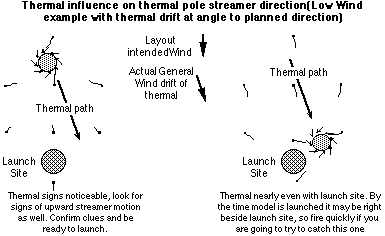 |
As shown in figure 7a, the first line of poles past the long rangepole should help show significant direction shifts. In this example,the left pole points right and the center and right poles point left.Other poles may show some influence as well. In figure 7b, thethermal has passed beyond the second line of poles and is nearlyalongside the launch site (it would be too ideal to show the thermalcoming right over the launch site since far more thermals pass byrather than directly through).
Temperature Sensing
A few people are sensitive enough to feel minute changes intemperature, but for most of us some form of sensing device isuseful. The primary device for sensing temperature is by using adigital thermometer, indoor/outdoor types having a wire lead for theoutdoor sensor being preferred. One like that is made by Haverhillsand others are sold through catalogs such as Heathkit or EdmondScientific. Other brands may or may not be as useful.
We have not tried them, but Radio Shack sells an assembledindoor/outdoor thermometer for $15, and an LCD temperatureindicator/controller module kit for $20 (the module is just aboutready to use as-is, except for adding switches or buzzer for otherfeatures). Unless you would like the novelty of having the module kitset off an alarm when a certain temperature is reached or recordingthe highest temp, the assembled one is probably just as well.However, there is one significant problem with both Radio Shackthermometers, and possibly other types as well. Their thermistors arecovered over by a metallic probe cover for protection, but which alsotends to act as a heat sink. That would hurt the responsiveness ofthe thermistor too much, by the time the warmer air heated the coverand then the air in the cover probe heated the thermistor, thethermometer readings would lag significantly behind the actual airtemperature. That is why the Haverhills type is so good, the smallthermistor is left bare and is quite responsive.
Radio Shack sells a separate thermistor for $2, it is the samekind as used in the Haverhills thermometer (rated 10K ohms at25°C). It MIGHT also be the thermistor used in one or both ofthe ones sold by Radio Shack. If so, the probe can be cut off andreplaced by the bare thermistor. If anyone does this, let us know howit works out. Well, a sad 2004 update...Radio Shack does NOT list thethermistor anymore. But you might still find some in stock at a localstore.
Something else of note about digital thermometers: sampling rate.For detecting thermals a sampling rate of at least once per second isdesirable. Some only take a sample every 5 or 10 seconds, or maybetake even longer than that. The longer the delay in sampling, theless useful the thermometer is.
Furthermore, the thermometer should read to a tenth of a degree.Thermometers that measure only to the degree are not accurate enoughand ones that read to the hundredth are too accurate.
Medical digital thermometers can be found at very low prices, $6or less. They would need the same separate thermistor/probe bypassmodification described above, but they may not be usable in any form.A test sample thermometer responded to temperatures in the90-106° range. While that might be useful for Texas, weatherusually is cooler so it would be useless. Perhaps other brands arenot as limited in their capabilities.
OK, so you have a thermometer, now what? It is a good idea to makeup a shield for the thermistor to protect it from sunlight. One kindof shield is shown in Figure 8 and is made from wood and styrofoam(foam 3/16" thick from a meat tray). The top disc is larger to helpprevent light coming in at diagonal angles, and the top has areflective covering to reduce heat absorption.
 |
The use of a shield will help prevent getting false readings fromheat induced by sunlight on the thermistor itself, after all thewhole idea is for the thermistor to reflect only air temperature.Along similar lines, if you have a simple hand-held "thermal wand"(the thermometer on a 3-4' dowel), you should be consistent about howit is pointed in reference to the sun - especially if you do not usea shield.
Also beware of abnormal locations that can throw off thetemperature reading. Setting up a thermistor on a car antenna mightbe convenient, but the heating of the car and pavement and howchanges in wind allow or prevent that very localized heated air to besensed by the thermometer could throw things off. Better to be out ina more open area. If the thermometer (or other thermistor heatsensor) is mounted to a pole it is preferable to mount the thermistoras high off the ground as possible to get a better reading of the airtemperature, 10-15 feet is better than 4-6 feet.
As for looking for a thermal, it is important to develop a feelfor the temperature readings you've seen in recent time. Whenthermals come and go the temperature tends to rise and fall. If thetemperature is dropping, a thermal is not likely. If the temperatureis rising, a thermal may be on the way. If the temperature is steadythen it may be a period in between thermals, or it may be a thermalpeaking if you have not been paying attention to what the temperaturehas been doing previously. This is where something such a chartrecorder becomes useful, in keeping track of temperature behavior andpossible cycles. Below is a sample from a homemade chartrecorder.
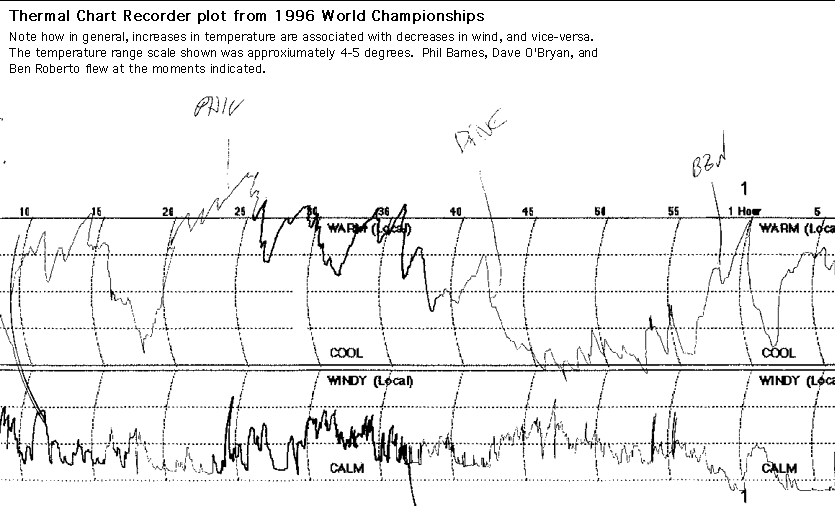
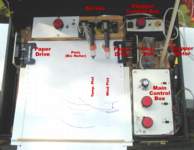 |  |
| | |
When there seems to be random air with no thermal activity, thetemperature will probably be relatively consistent, not changingmuch, or not very quickly. On an average "good" day for thermals,when a thermal does come through there may be a rise of from 2 to asmuch as 4 degrees F, depending on the day, thermal strength, andnearness to the core. This is by not means an absolute, and on poorerdays there may only be about a degree of change notable. Temperatureis hard to go by sometimes, on calmer days the temperature may seemto get higher and higher, but only slowly. In those cases the problemis in firing too early before conditions have peaked. The ideal cluesfor a thermal to give off are a relatively rapid rise in temperature,which may mean the core of an existing thermal is nearing rather thana thermal bubble just beginning to form.
When a temperature rise seems to indicate a thermal, other cluesshould also be studied. Changes in wind direction and velocity whichmay help to locate the location, and when the thermal is nearer lookfor clues of upward air motion from streamers, bubbles, and whateverelse is available. Temperature tends to drop rapidly after thethermal core passes through. If the temperature begins to drop youeither need to fire right away if you think it is some lift you canuse, or not fire at all. Once the temperature has begun to dropsignificantly and the wind picks up, the only thing you are likely tocatch is massive down air. Then you'll have to start waiting for thewhole cycle to repeat again, hopefully with something better.
| 2008 update: WSMC in Spain, with Kestrel recording anemometer plotting temperature |
| | | |  |
| | with Thermal Pole | Kestrel anemometer | as a time graph |
Bubbles
Free Flight airplane fliers have used things like cat-taillfluffies and bubbles to detect rising air. Bubbles are far simplerthat cat-tail fluffies (I wonder how many F/F airplane sites startedgrowing cat-tails, that never had them before? Those fluffies arealso SEEDS. Good thing "Kudzu" was never useful for picking lift!).You can use bubbles the old fashioned way, blow them yourself, butthey are a lot more useful when generated by a bubble machine set upa ways upwind. I first found a GREAT bubble machine at Toys R' Usaround 1990 or so, the "Bubble Blaster" which was meant to be used asa game rather than just a bubble machine. Some F/F airplaners hadmentioned how good it was. Ed LaCroix bought up a number of them andsold them for awhile, till he ran out. Unfortunately the companymaking it had already stopped making it, so Ed only was able to get afew from Toys R' Us. There's been other machines around since thenbut none has been quite as good for bubble quality and quantityversus portability and ease of use. Fisher-Price had some toy lawnmowers that made bubbles, the one I got years ago produced very poorquality and very small bubbles. In recent years, there's been morereal bubble machines found listed. Unfortunately, some of them runoff of 110/120 volts AC. Well, it's not too practical to use those,though it has been done with a voltage inverter running off a 12 Vcar battery. So, it's best to go for one that runs off of batteriesup to "D" cell size (or off of external power such as a gel cellwith a regulator to keep the voltage down to what the machine uses,such as 3 volts).
I previously had a list of links to bubble machines that were soldatthe time, but over time the machine model types come and go. So,there is not much point in posting links to a specific machine today,as it may be gone in a few months. Below left is an example of abattery-operated machine. Some machines work better than others.
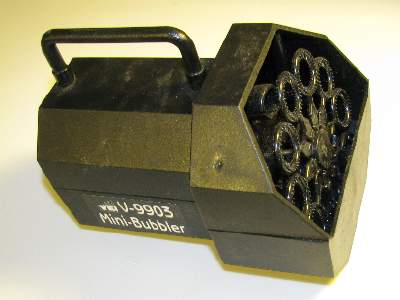 | 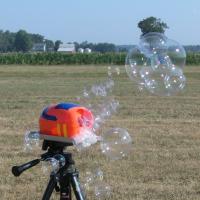 |
| | |
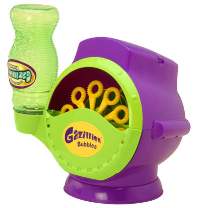 |  | 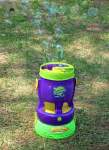 |
| | | |
OK, I will list one link. For the "GazillionBubbles" machines made by Sunrise. Hopefully the link will staygood. If not, simply look for "Gazillion Bubbles" machines in storeslike Wal-Mart and Toys-R-Us. There is a very wide variety ofmachines. Above, second from left, is one that I have, which puts outa huge amount of bubbles. The item attached to the left of it is abottle of bubble liquid to help self-refill it for longer than itruns without it. That one puts out so many bubbles, using so muchliquid, that it would actually be best to block off 50% or more ofthe bubble wands. In doing a web search to find an image of that one,I ran across the Gazillion bubbles "Typhoon" model. This one blowsthe bubbles up vertically, so the bubbles not only get blown higherup, but there should not be issues with wind as sometimes interfereswith other bubble machines. Also it seems like it holds a lot ofbubble liquid. I have not tried it, of course. And as I make thisupdate to this page in December, 2008, I realize that machine mightnot even be around for summer 2009, but hopefully the GazillionBubbles brand will stick around a good long time.
As for learning about thermal clues, you can go out to the flyingfield and just watch the bubble machine continuously without flyingany models. By studying them long enough you may note particularbehavior that may indicate a thermal. Even better if there is athermal pole or two set up, and some other models in the air to helpshow what really is or is not a thermal.
The higher off the ground the bubble machine is, the better itwill interact with the air to show lift. Six feet would be good,though difficult to refill above eye level. If the bubble machine ismounted on a tripod for ease of repositioning due to permanent windshifts, such high mounting will probably have to be sacrificed asmost tripods are only 3-4 feet tall.
As for location, if you have one machine it is good to set it upat some distance upwind of the launch site, say 100 feet on a lowwind day and somewhat more on windier days so there is time toidentify a thermal before it has come by the launch site. Locating itlonger distances away is somewhat of a problem in frequently turningit on and off, to conserve batteries/liquid and also for strategicreasons (for US Team flying it would be desirable to have the bubblemachines running only when needed for picking air for a US Teammember, and having them off the rest of the time). With more bubblemachines, like poles, various layouts can also be used. If you havetwo machines, one can be far upwind, the other very close to the padarea for convenience. In the case of US Team flying the bubblemachine layout could be planned in conjunction with the thermal polelayout.
The initial clues given off by bubbles will be shifts in winddirection, which may indicate the approach of a thermal. Upwardmovement of the bubbles is a very good sign, though do not beconfused by turbulence that randomly makes the bubbles rise a bit,look for something more definitive. If the bubbles rise up about 20feet, that may be lift, if they rise toward 50 feet and seem to berising rapidly it must be lift! As will all thermal picking, look forother clues as well to help confirm what seems to be lift.
On some rare occasions you may see another good sign. The bubblesmoving around in a horizontal circular pattern. Assuming this is inan open area, and not turbulence off an upwind structure or line ofcars, this most likely is the core of the thermal becoming visible bymeans of the bubbles. On one occasion the bubbles have been seen tobe pulled up in a rotating spiral, as the core went right by a bubblemachine.
On the flip side, if bubbles just drift along the ground withoutrising there is no lift. If the bubbles do not even drift far butdrift into the ground and pop there is no lift and possibly even downair. On windier days the bubbles may be of little or no use at alldue to turbulence.
One thing a bubble machine is good for aside from finding thermalsis to gain an understanding of how complex the air behaves indirection, velocity, and stability. It is likely that anyone who getsa bubble machine will spend some significant time either "testing" or"playing" with the machine at home, outdoors. The contours ofresidential areas does not make for any kind of logical learningabout thermals. But while testing out the machine operation, bubbleliquid types, and so on, you can notice how the bubble drift anddispersal changes a lot. Unless a particularly windy day the winddirection changes frequently, and updrafts occur to take the bubblesup. You can also even make the bubbles "slope soar" up and over ahouse or building. Observing the drift of the bubbles may give you abetter feel for how variable the wind really is, and how it interactswith surface obstacles even on a micro-meteorological scale.
Other equipment and clues
An outgrowth of the thermal pole is the thermal balloon. Such as a3' dia balloon with a few dozen yards of line, with mylar streamersattached to a number of locations on the line. Such an arrangementcan show air behavior more completely at different altitudes.However, this is not so easy to arrange to do, and has only beenknown to have been done at the 1980 WSMC in Lakehurst. Perhaps weshould try it again!
Natural signs can be used to help locate lift. Trees can beobserved for changes in wind velocity, as can other objects affectedby wind (look for flagpoles as well). Birds can be useful; birds thatsoar are obvious for showing a thermal. Another way is fornon-soaring birds to be seen flitting around in the same area of skyanywhere form 20 to 100 feet up, catching bugs that have been pickedup by a thermal. Bird clues cannot be relied to occur, but when theydo occur should be recognized as possible strong signs.
Your surroundings can give off clues also. Sometimes noticing howa field of grass, wheat, or corn sways will graphically depict athermal. From this, just enlarge your field and look at trees andside objects. Then time the launch to hit the thermal.
Final comments
If you're on the US Team flying duration, you ought to have atleast one thermal pole, if not more, and bring it to be used at FAIcontests. And help set up some of the thermal gear such as the poles,even if only 1-2 people are in "charge" of picking thermals, there isalways a need for help before and after the event for setting up andpacking gear.
Under FAI round type flying where there is often no more than 20minutes for each team member to fly, there may not even be one decentthermal, so the strategic impact of waiting too long has to beconsidered too, passing up something moderate in hopes of somethingbig can be a big gamble. The first person up for the round cannotwait 30 minutes and then leave only an average of 15 minutes for histeammates to fly in (unless it is round three and only one member hasa shot at a medal or making the flyoffs. Then the manager might allowthat flier to have special priority on when he goes or how long towait). This also puts a premium on getting your model ready to fly atthe beginning of the round if you are first up, or to be ready to putyour model on the pad the moment the team member in front of you haslaunched. Medals have literally been won or lost this way.
When deciding when to go, also keep in mind how fast the thermalis drifting and how slow the launch crew may be. Some crews are fast,some are slow. It does no good to pick the perfect thermal, wait tothe last moment to signal to launch, and have the model launched20-30 seconds later when the thermal may have passed through.
Related Articles
Authors (this article): Ken Mizoi & GeorgeGassaway
References:
Bill Forrey, Model Builder, July 1989.
Dave Thornburg's "River of Air" Model Builder Magazine ariticles,as well as in his "Old Buzzard's Soaring Book".
George Gassaway, Technology Development Mailing, October 1990.
This article originally appeared in the January 1993 issue of the"Journal of the International Space Modeling Society."
|
|